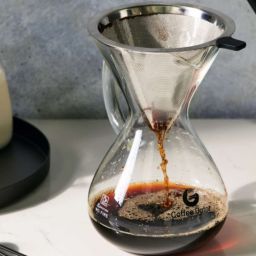
Many of us can’t imagine starting our day without a warm cup of coffee. It’s more than just a morning ritual; it’s a delightful source of comfort and energy. However, not everyone is aware of how the additions to their coffee, like milk and sugar, can significantly impact its calorie content.
Understanding these details is crucial, especially for those mindful of their dietary intake or those trying to manage their weight. This guide aims to demystify the caloric implications of these common coffee additions, helping you make informed choices that align with your health and wellness goals.
Key Takeaways about Calories In Coffee With Milk And Sugar
- Impact of Milk and Sugar: The calorie count of your coffee largely depends on what you mix into it. A simple splash of milk or a spoonful of sugar can transform your nearly calorie-free black coffee into a more indulgent treat.
- Managing Dietary Goals: By understanding how different types of milk and sugar affect the calorie content of your coffee, you can better manage your daily caloric intake. This knowledge is particularly helpful for those tracking their calories for weight loss or health maintenance.
- Options for Lower Calories: Opting for skim milk or sugar-free syrups can drastically reduce the calorie content of your coffee. These alternatives offer a way to enjoy your favorite beverage without straying from your dietary goals.
What Are the Calories in Coffee with Milk and Sugar?
A simple cup of black coffee contains only about 2 to 5 calories. However, when you start adding milk and sugar, the calorie count begins to rise, which might affect your dietary goals if you’re not careful. Here’s how different additions can change the calorie content of your coffee:
- Black Coffee: Virtually calorie-free, offering only about 2 calories per 8 oz. serving.
- Sugar: Each teaspoon of sugar adds about 16 calories. If you prefer your coffee sweet and add a couple of teaspoons, you’re adding over 30 calories.
- Milk: The type of milk used can vary the calorie addition significantly. A tablespoon of whole milk adds about 9 calories, while the same amount of skim milk adds just 5 calories.
Types of Milk and Their Impact on Calorie Content
The choice of milk can dramatically affect the calorie count of your coffee. Here’s a brief overview of how different milks compare:
- Whole Milk: Rich and creamy, whole milk adds about 150 calories per cup (240ml). It’s popular in coffee shops for its taste and texture.
- Skim Milk: A lighter alternative, skim milk provides about 80 calories per cup, making it a favorite for calorie-conscious consumers.
- Oat Milk: With a creamy texture and a slightly sweet flavor, oat milk brings approximately 120 calories per cup.
- Almond Milk: The lowest in calories among the popular options, unsweetened almond milk contains about 30-40 calories per cup.
Sugar and Its Alternatives
When it comes to sweetening your coffee, the choices and their impacts on calorie count are vast. Regular table sugar adds about 16 calories per teaspoon, making it a significant contributor if you like your coffee sweet. Brown sugar, often chosen for its rich flavor, has nearly the same caloric value, adding a similar calorie count to your cup.
For those looking to reduce calorie intake, sugar-free alternatives offer a sweet taste without the added calories. Artificial sweeteners like sucralose or aspartame provide a sweetness many times that of sugar, allowing you to use much less without contributing calories. Natural sweeteners like stevia are also popular, offering a calorie-free sweetness derived from plants.
However, it’s essential to consider the health implications of these alternatives. Some studies suggest that excessive consumption of artificial sweeteners may have health risks, such as affecting gut health or insulin sensitivity. As always, moderation is key, and it’s wise to consult with a healthcare provider if you have concerns about your diet.
Additives That Increase Calorie Count
Beyond sugar, other additives like syrups and creamers are popular for enhancing the flavor and texture of coffee but can significantly increase its calorie content. For instance, a single pump of flavored syrup can add about 20-25 calories, and gourmet syrups like caramel or vanilla are often used more liberally, which can quickly add up.
Creamers, especially flavored varieties, are another substantial calorie source. A tablespoon of a typical half-and-half creamer adds about 20 calories, while flavored creamers can add more, depending on the type and amount used. These additions can turn a simple cup of coffee into a calorie-dense treat, comparable to a dessert.
Beverage Variations and Their Caloric Profiles
Exploring different coffee preparations not only adds variety to your daily routine but also affects the calorie count of each cup. Here’s how some popular coffee drinks stack up:
- Espresso: Known for its strong flavor and thick crema, a single shot of espresso contains only about 1-2 calories, making it a low-calorie option for coffee lovers.
- Latte: A latte combines espresso with steamed milk and a light layer of foam. The calorie content mainly depends on the type of milk used. For example, a standard latte with whole milk can contain around 150 calories for a regular 8-ounce serving. Opting for skim milk can reduce this to about 100 calories.
- Cappuccino: Similar to a latte, but with more foam and less milk, a typical cappuccino has slightly fewer calories than a latte due to the higher air-to-milk ratio. A regular cappuccino with whole milk contains about 120 calories.
FAQs
Does black coffee contain calories? Yes, but very few. A typical 8-ounce cup of black coffee contains only about 2 calories, making it an excellent choice for those watching their caloric intake.
How does adding milk or sugar change the calorie count? Adding milk and sugar increases the calorie content of your coffee significantly. For instance, adding one tablespoon of whole milk adds about 9 calories, and each teaspoon of sugar adds about 16 calories. Therefore, customizing your coffee with these additions can quickly increase its caloric impact.
What are the lowest calorie options for coffee with milk and sugar? To minimize calorie intake while still enjoying a flavored coffee, consider opting for skim milk, which adds fewer calories than whole milk, and using sugar substitutes like stevia or sucralose, which provide sweetness without the calories. Another option is to use unsweetened almond milk, which is lower in calories than dairy milk.
Final Thoughts
Throughout this exploration of coffee and its caloric implications, we’ve learned that the simple act of adding milk, sugar, or flavorings can transform a nearly calorie-free beverage into a significant source of calories. Understanding the calorie content of different types of milk and sugar, as well as alternative options, enables you to make more informed choices based on your dietary needs and preferences.
If you’re trying to keep your calorie intake in check but still want to enjoy a flavorful cup of coffee, consider choosing low-calorie milk options and sugar substitutes. By doing so, you can enjoy your daily coffee ritual without compromising your health goals.









